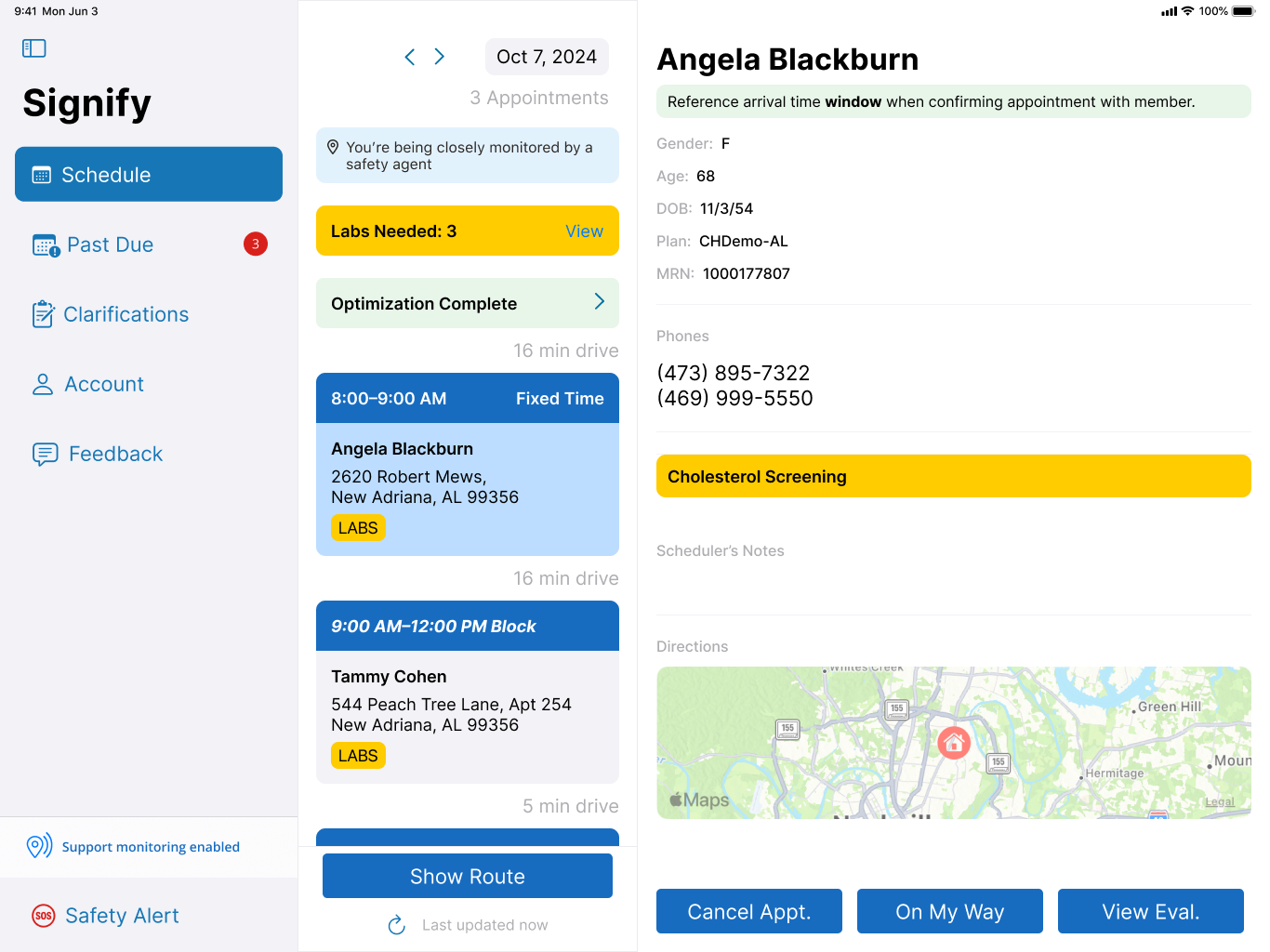
Signify Health
MySignify Safety Toolkit
MySignify is Signify’s clinician daily workforce mobile app that supports our network of providers to conduct in-home patient assessments.
Problem
Signify Health provides evaluation for Medicare and Medicaid members conducted by traveling clinicians that meet the member in their home. Although most of our evaluations go on well without concerns, some clinicians have experienced minor and extreme accounts of safety incidents both on route and during an evaluation. Our product, engineering, and leadership teams have aligned on ensuring safety is at the forefront of a clinician’s journey at Signify to improve the overall experience and their safety sentiment. Through various discovery methods (interviews, workshops, surveys, etc), we were able to determine and prioritize clinician’s access to safety resources as a feature to introduce to our clinician-facing applications.
Clinicians have access to two applications at Signify Health. They have access to MySignify, a mobile app (iOS and Android) they can install on their phone, and an iPad, supplied by Signify, that houses their in-home evaluation/clinical application they use during an appointment. These safety features needed to be built across both platforms and applications to access emergency services at any time during their day-of-service. And because we would be partnering with Everbridge, a third-party vendor integration and their call center support, we needed to make sure to incorporate their capabilities.
My role
I lead the end-to-end design and research for the safety team from October 2023 to present, including: design strategy, user research, workshops facilitation, and wireframes and prototype creation.
In strategic collaboration and partnership with:
Shivam Patel, Product Manager
Jennifer Conlon, Eng. Manager
Nike Frangules, Sr. Dir. Product Mgt
Sangeeta Shah, Eng. Dir.
Sam Wheeler, Sr. UX Designer (recent hire, Oct. 2024)
Design strategy
I’ll be focused on the mobile and iPad designs for safety toolkit designs and concept validation.
I do want to note that the design process is not always linear, and our end-to-end process was no exception. However to better represent our process, I’m embedding key foundational research, workshop or design methods we used in the Double Diamond framework.
This is an overview of the different design and research tactics we used to better understand the problem space, the users, prioritization of key features and functionality, and opportunities to ground our work. Happy to discuss any of these in more detail.
Discovery
Clinician safety interviews
Clinician safety sentiment & suggestions survey
Competitor/comparator analysis
Safety incident call reporting analysis
Safety incident brainstorming workshop
Panic button in mobile devices research papers review
Define
Clinician persona creation
Customer Experience Outcomes and durable statements research
Importance/Impact prioritization matrix
Third party vendor (RapidSOS) capabilities exploration
User journey and flows
Design
Design iterations
Concept validation user testing
MVP expectations and goals
Deliver
Design files and annotations
Engineering collaboration
Internal quality testing and review
Next steps
Training resources, job aids, and video
Behavioral analytics
Support training and response
Adjustments after concept validation
What’s concept validation?
It’s a method to present flows or product ideas to establish fit and if the product is addressing key customer needs. I did this by using a few tactics:
Think-aloud testing
Scenario & probing questions
System Usability Scale (SUS) questions
Semi-Usability Heuristics Evaluation
The insights generated from concept validation were the need for visibility and prominence within the iPad. Clinicians expressed that the colors and context stood out and were easily identifiable during emergency situations. Labels needed more clarity and expressed concerns with consistency across devices.
Clinician safety sentiment
Our clinicians have indicated through a survey that safety throughout their tenure at Signify is important to them and is an opportunity that would have an impact on their confidence going into a member’s home. After our concept validation testing, we received a resounding amount of interest in the features provided. However, our clinicians also indicated the need for discretion on the devices and concerns about not having internet or a cellular connection for those that travel to rural communities.






